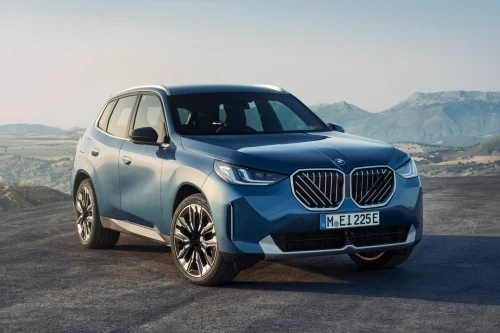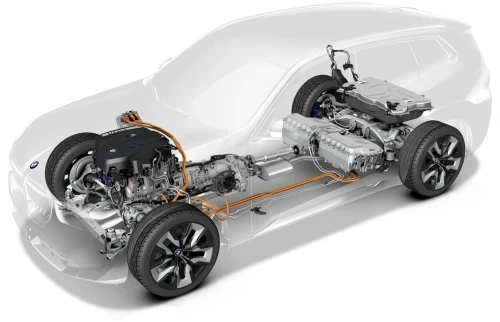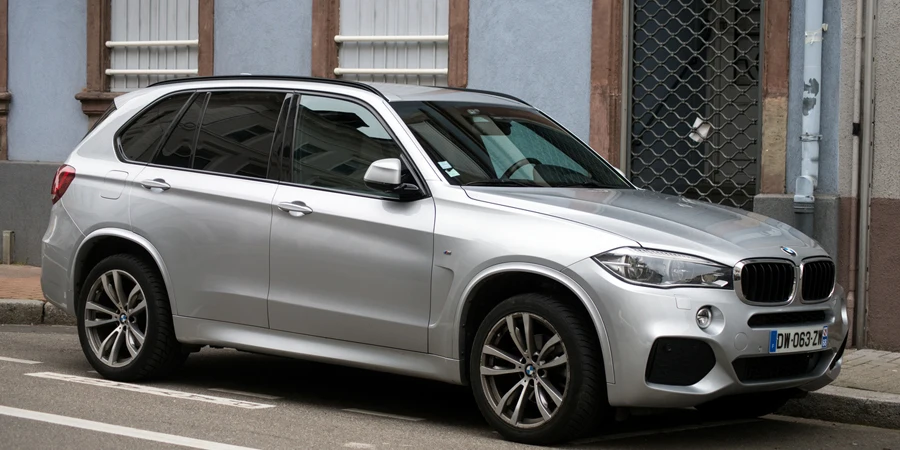BMW launched the fourth-genetation of its X3 featuring major improvements in efficiency and dynamic performance with the wide-ranging model line-up. The portfolio of powertrains comprises not just highly efficient gasoline and diesel engines, but also a latest-generation plug-in hybrid system that enables the new BMW X3 30e xDrive (consumption, weighted and combined: 24.0 – 22.3 kWh/100 km and 1.1 – 0.9 l/100 km; CO2 emissions, weighted and combined: 26 – 21 g/km in WLTP cycle; fuel consumption with battery empty: 7.9 – 7.2 l/100 km in WLTP cycle; CO2 classes: with battery empty G – F; weighted and combined B) to achieve an electric range of 81 – 90 kilometers (50 – 56 miles) in the WLTP cycle.
The new BMW X3 will be built at BMW Group Plant Spartanburg (USA) and Plant Rosslyn (South Africa) using a production process focused on conserving resources and circularity. Its market launch will get underway in Europe and the USA in the fourth quarter of 2024, progressing across numerous other markets from January 2025.

Fifth-generation BMW eDrive technology for plug-in hybrid drive systems makes for much sharper power delivery in the new BMW X3 30e xDrive, while also achieving a noticeable increase in electric range compared to the outgoing model. Its plug-in hybrid system consists of a latest-generation four-cylinder gasoline engine and an electric motor that likewise comes in an extensively updated version and is integrated into the model-specific eight-speed Steptronic transmission.
The 2.0-liter gasoline unit in the new BMW X3 30e xDrive generates maximum output of 140 kW/190 hp and peak torque of 310 N·m (229 lb-ft). The electric motor developed for the hybrid drive system is integrated—together with its power electronics—into the eight-speed Steptronic Sport transmission, saving weight and space. It contributes up to 135 kW/184 hp to the maximum system output.
A pre-gearing stage patented by BMW enables its nominal torque of up to 250 N·m (184 lb-ft) to be increased to an effective torque of up to 400 N·m (295 lb-ft) at the transmission input for the motor. The compact electric motor is therefore able to boost torque by an amount that would normally only be possible using a larger unit and makes a clear difference both when accelerating off the line and putting in a quick burst of speed.

The two power units combine to increase system output to 220 kW/299 hp in the new BMW X3 30e xDrive, while maximum combined torque has been upped by 30 N·m (22 lb-ft) over its predecessor to 450 N·m (332 lb-ft). This enables the new BMW X3 30e xDrive to accelerate to 100 km/h (62 mph) from rest in 6.2 seconds. Top speed is 215 km/h (134 mph) with the car reaching a maximum of 140 km/h (87 mph) in pure electric mode.
The proactive energy management has undergone further improvement. Consequently, the most efficient operating mode is always selected as a function of the route profile and the battery’s charge level. When HYBRID mode is activated, the combustion engine is started in plenty of time before joining a highway to allow the driver to accelerate at full power and, at the same time, optimize the battery charge. In ELECTRIC mode, the engine is completely disconnected from the drivetrain using a separating clutch in the eight-speed Steptronic transmission.
The high-voltage battery in the new BMW X3 30e xDrive is also a product of fifth-generation BMW eDrive technology and now has a considerably higher energy content. Located under the rear seat, the battery pack provides 19.7 kWh of usable energy—nearly twice as much as before. This has also led to a commensurately large increase in the new model’s electric range, which now comes in at 81 – 90 kilometers (50 – 56 miles).
The new BMW X3 30e xDrive is fitted with the Combined Charging Unit (CCU) for handling the coordination of all charging currents. Based on fifth-generation BMW eDrive technology, this charging unit keeps the electric drive system fed with an extremely effective, precision-controlled supply of power, while also ensuring the high-voltage battery is charged quickly and efficiently. It also acts as a voltage transformer for supplying the vehicle’s electrical system.
The CCU now allows the high-voltage battery to be charged at 11 kW as standard—nearly triple the rate of the outgoing model—and supports both single-phase and three-phase AC charging. The battery can be fully recharged from empty in 2h 15min.
In Europe, the new BMW X3 30e xDrive is supplied as standard with a charging cable (mode 3) for use at public charging stations. A Flexible Fast Charger for charging at home or at work is offered as an option. The plug-in hybrid model is also compatible with the latest offering from BMW Charging: the Connected Home Charging option provides a basis not just for solar-optimised and load-optimized charging, but also cost-optimised charging using a dynamic electricity tariff.
48V mild hybrid technology for gasoline and diesel engines. Systematic electrification instils all other variants of the new BMW X3 with very sharp power delivery and increased efficiency courtesy of 48V mild hybrid technology. Two different systems are used here.
- The four-cylinder diesel unit in the new BMW X3 20d xDrive teams up with a starter generator integrated into the belt drive, which delivers a power boost of 8 kW/11 hp and maximum torque of 25 N·m (18 lb-ft).
- In the gasoline-engined BMW X3 M50 xDrive and BMW X3 20 xDrive, on the other hand, the 48V mild hybrid system consists of an electric motor that acts as a crankshaft-mounted starter generator and, as with the plug-in hybrid model, is integrated into the housing of the eight-speed Steptronic transmission together with its power electronics. It generates torque of 200 N·m (147 lb-ft) and up to 13 kW/18 hp of extra power, depending on the driving situation, helping the combustion engine to deliver a smooth, dynamic and, at the same time, efficient drive. The crankshaft-mounted starter generator of the gasoline models additionally enables purely electric driving at very low speeds, such as when parking and maneuvering.
Both versions of the 48V mild hybrid technology result in remarkably instantaneous response to the slightest movement of the accelerator—when pulling away and also when putting in a sudden burst of speed—as well as more comfortable operation of the Automatic Start/Stop function.
The energy required for the electric power boost is stored in a 48V battery located under the luggage compartment. It is charged by means of energy recuperation in overrun and braking phases. This provides an efficient means of recovering a very large portion of the braking energy that has gone unused in the past. As well as supplying the electric motor, the 48V battery also feeds power to the vehicle’s 12V electrical system via a voltage transformer.
Powerful, free-revving gasoline engine in the new BMW X3 20 xDrive. The 2.0-liter four-cylinder gasoline unit from the new generation of engines that can be found under the hood of the BMW X3 20 xDrive offers instantaneous power delivery, a healthy appetite for revs and exemplary efficiency. Besides the 48V mild hybrid technology, this is mostly the result of extensive upgrades to the core engine.
The array of innovations includes the Miller cycle (which shortens the opening time of the intake valves); redesigned intake ports and combustion chambers; and an ignition system featuring an active coil with integrated electronics.
Mixture preparation is optimized using a new dual injection system. In addition to the existing high-pressure injection system, some of the fuel is now injected into the combustion chambers via a low-pressure system.
At the same time, the performance of the turbocharging system and intercooler has also been improved. Switchable rocker arms on the exhaust side of the VALVETRONIC variable valve timing form the basis for enabling purely electric driving at extremely low speeds.
The new power unit generates maximum output of 153 kW/208 hp (developed by the combination of the combustion engine with up to 140 kW/190 hp at 4,400 – 6,500 rpm and the integrated electric motor with up to 13 kW/18 hp) and peak torque of 330 N·m/243 lb-ft (developed by the combination of the combustion engine with up to 310 N·m/229 lb-ft at 1,500 – 4,000 rpm and the integrated electric motor with up to 200 N·m/147 lb-ft). This enables the new BMW X3 20 xDrive to accelerate to 100 km/h (62 mph) from rest in 7.8 seconds.
Combined fuel consumption is 7.6 – 6.9 liters per 100 kilometers and CO2 emissions of 172 – 156 grams per kilometer in the WLTP cycle.
Latest-generation diesel engine in the new BMW X3 20d xDrive. The four-cylinder diesel unit in the new BMW X3 20d xDrive has been made more powerful and more efficient. In addition to the 48V mild hybrid technology, it also features a lightweight crankcase with low-friction pistons made from tempered steel and a graphite coating for the piston skirts, as well as an active oil separator with map-regulated electric drive.
The BMW TwinPower Turbo technology at the heart of the 2.0-liter engine has likewise been updated. In an effort to cut fuel consumption and emissions, improvements have been made to the efficiency of the two-stage turbocharging and to the common-rail injection and exhaust gas recirculation systems.
The new unit posts maximum output of 145 kW/197 hp, with peak torque standing at 400 N·m (295 lb-ft). The new BMW X3 20d xDrive accelerates from 0 to 100 km/h (62 mph) in 7.7 seconds. The car’s superior efficiency is reflected in combined fuel consumption and CO2 figures of 6.5 – 5.8 liters per 100 kilometers and 171 – 153 grams per kilometer in the WLTP cycle.
Eight-speed Steptronic transmission with gearshift paddles as standard. The power units available for the new BMW X3 are all mated to the eight-speed Steptronic transmission in a model-specific design as standard. The high-voltage electric motor for the BMW X3 30e xDrive and the crankshaft-mounted starter generator on the BMW X3 20 xDrive are both integrated into the respective version of the transmission.
All variants of the new automatic transmission can be noted for their reduced weight, even smoother gear changes and the sharper shift action resulting from their refined hydraulic control. An electrically operated oil pump keeps the transmission lubricated and maintains oil pressure during phases when the engine is switched off due to activation of the Automatic Start Stop or coasting functions.
Due to the transmission control’s intelligent networking, it can take into account the data on route profile and the traffic situation supplied by the navigation system and driver assistance systems in order to optimise the shift strategy for sporty performance and efficiency. This makes it possible, for example, to shift down early when approaching a junction, a sharp bend or a vehicle ahead.
Further tweaks to performance, weight, efficiency and acoustic comfort of BMW xDrive all-wheel-drive system. The BMW xDrive all-wheel-drive system fitted as standard on all model variants of the new BMW X3 also features an extensive package of updates. The pioneer of intelligent all-wheel drive is now in its fourth generation and controls the distribution of power to the wheels to suit requirements in an effective and efficient manner.
An electronically controlled multi-plate clutch in the transfer case networked with the powertrain and chassis systems takes care of distributing drive torque swiftly and precisely between the front and rear wheels as the driving situation demands. The rear-wheel bias of the BMW xDrive system enhances traction and agility, along with the brand’s familiar cornering prowess.
The latest version of the transfer case is able to relay even greater torque to the front wheels. In addition to this, the thermal load on the system in extremely dynamic driving situations has been lowered. The enhanced performance capabilities also herald a reduction in weight. A new system of oil level control on demand further increases the efficiency of BMW xDrive. The introduction of a central mounting for the transfer case helps to improve the drive system’s acoustics and also to reduce the amount of vibration that reaches the body of the new BMW X3.
Source from Green Car Congress
Disclaimer: The information set forth above is provided by greencarcongress.com independently of Chovm.com. Chovm.com makes no representation and warranties as to the quality and reliability of the seller and products.





 বাংলা
বাংলা Nederlands
Nederlands English
English Français
Français Deutsch
Deutsch हिन्दी
हिन्दी Bahasa Indonesia
Bahasa Indonesia Italiano
Italiano 日本語
日本語 한국어
한국어 Bahasa Melayu
Bahasa Melayu മലയാളം
മലയാളം پښتو
پښتو فارسی
فارسی Polski
Polski Português
Português Русский
Русский Español
Español Kiswahili
Kiswahili ไทย
ไทย Türkçe
Türkçe اردو
اردو Tiếng Việt
Tiếng Việt isiXhosa
isiXhosa Zulu
Zulu